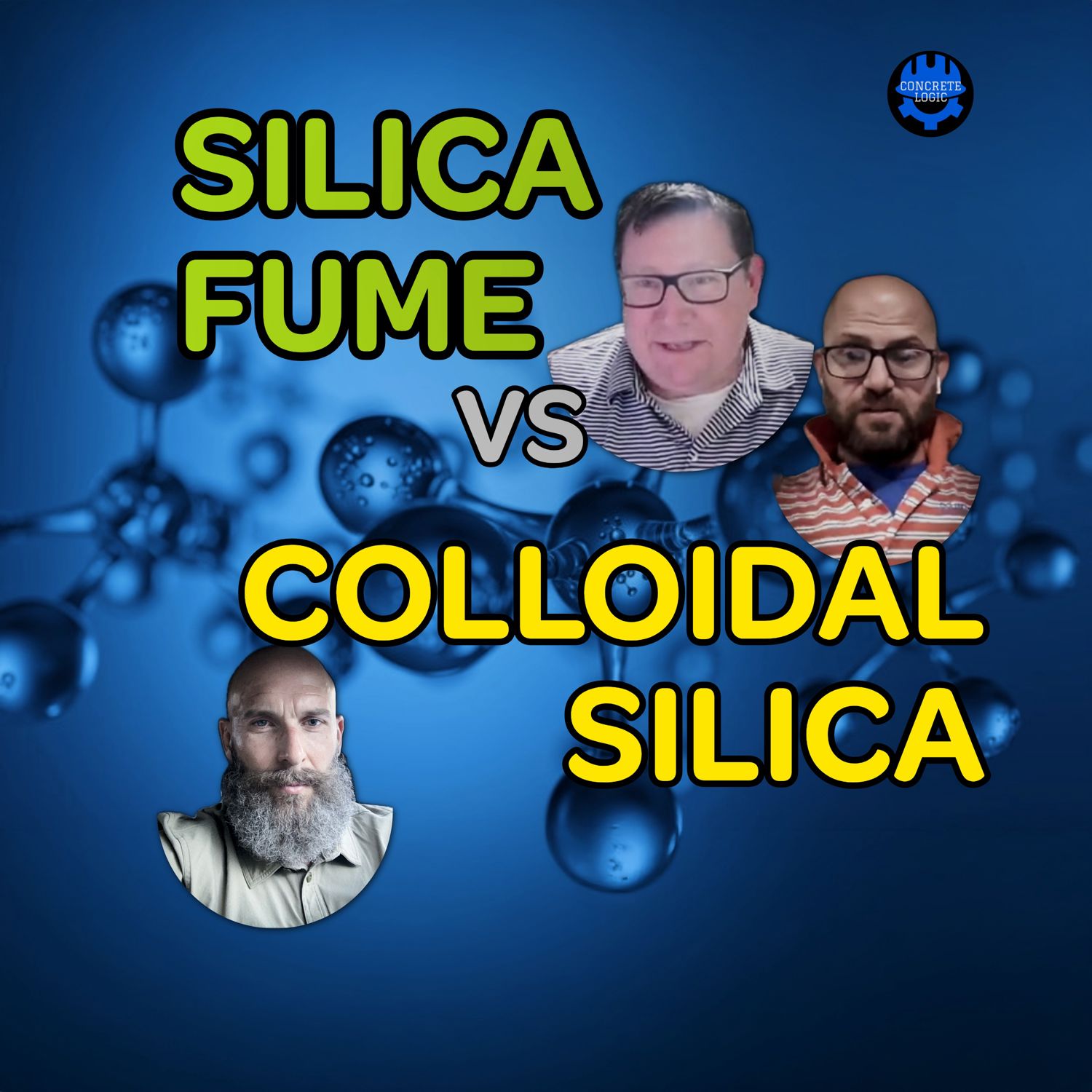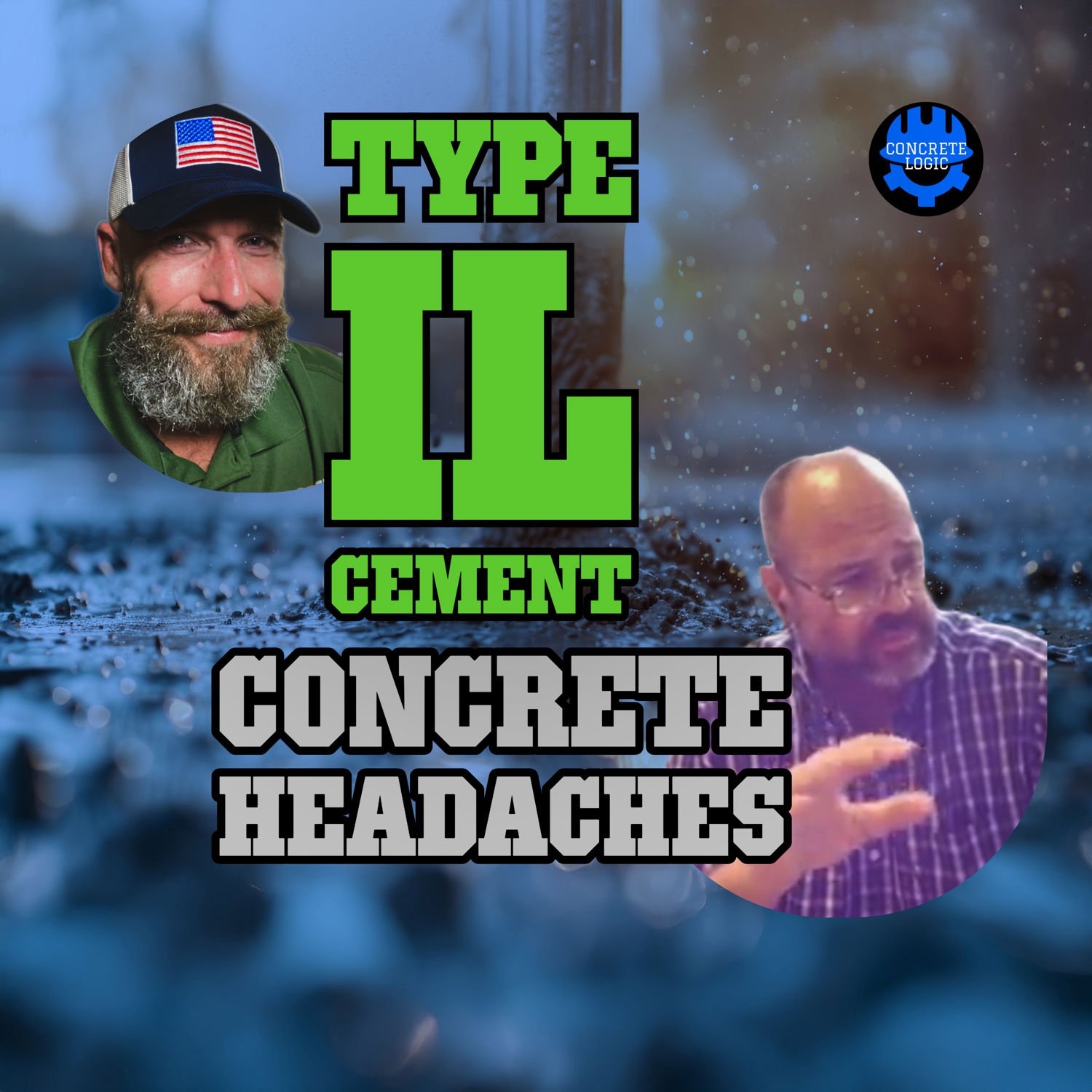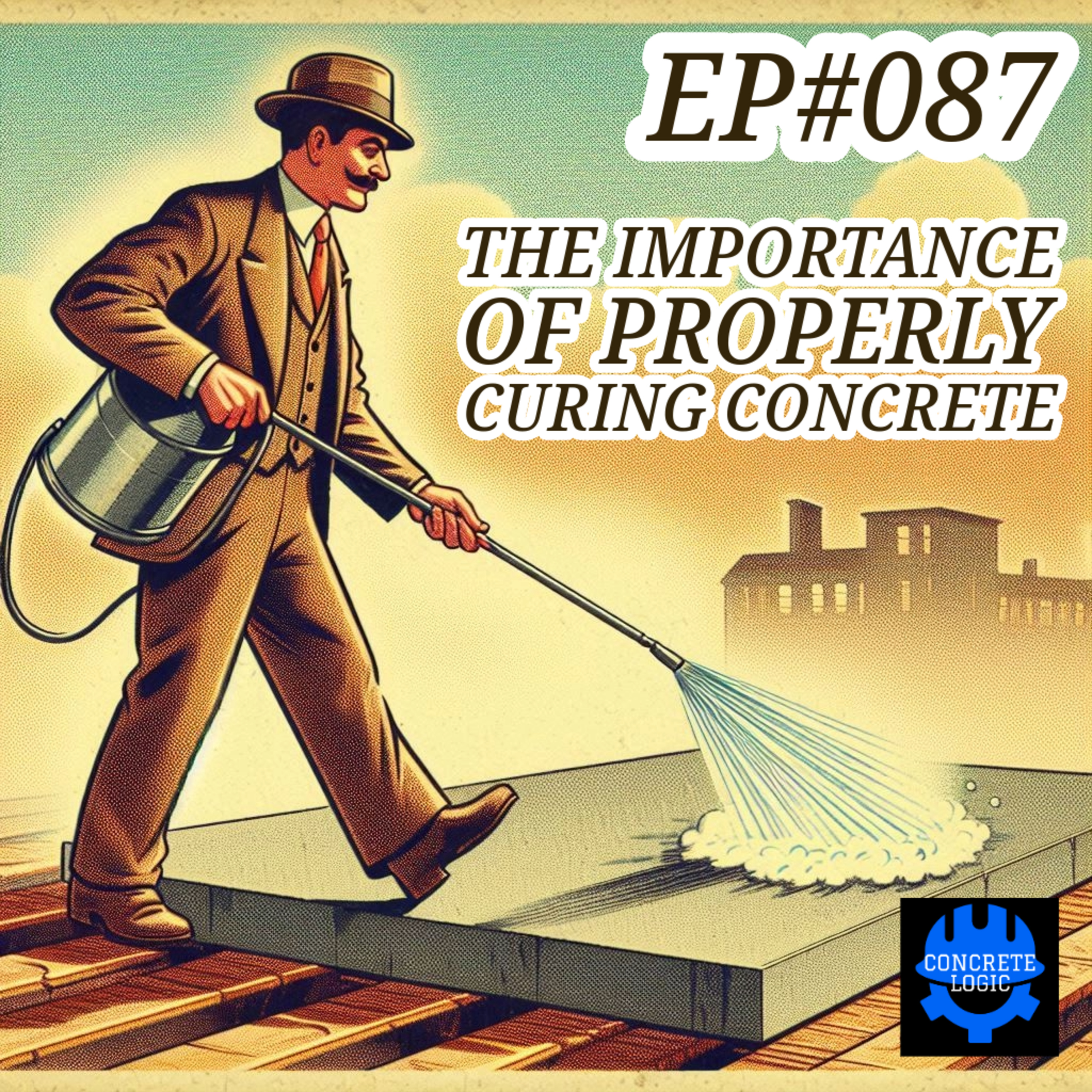EP #123: WTF Happened to This Slab? Concrete Fail Costs That’ll Make You Sick

A photo that looks like the surface of the moon—but it’s a warehouse slab.
In this episode, Dr. Jon Belkowitz and Seth Tandett break down what went wrong, how these concrete disasters spiral into lawsuits, and why bad finishing techniques can cost $200 per square foot in repairs.
Contractors, RMX suppliers, engineers, and specifiers—this is your crash course in concrete accountability, moisture failures, and job site reality.
What You'll Learn in this episode:
- What can a flashlight reveal about a slab finish that traditional testing can’t?
- How can a $5/sqft floor repair balloon into a $200/sqft lawsuit?
- Why are skilled finishers vanishing—and what’s replacing them?
- What happens when the wrong concrete is used under vinyl tile?
- Who usually gets blamed (and pays) when slab issues surface after the pour?
- What role do insurance companies play when concrete jobs go sideways?
- Is petrography necessary before deciding to grind or rip out a slab?
- Why is concrete such a bad substrate for resilient flooring?
- When does grinding a floor become worse than ripping it out?
- What legal landmines are hidden in the flooring section of your specs?
CHAPTERS:
00:00 Exploring the Lunar Surface: A Unique Perspective
02:51 Concrete Insights: Understanding Surface Finishing Techniques
06:04 The Labor Crisis in Construction: A Growing Concern
08:59 Accountability in Construction: Who's Responsible?
12:01 Built-in Obsolescence: The Cycle of Repairs
14:57 Insurance Claims and Legal Implications in Construction
17:58 Cost Considerations: The Price of Remedial Work
19:44 Understanding Liquidated Damages
20:38 Quality Control in Construction
23:08 Communication Between Contractors and GCs
25:51 Addressing Concrete Issues Promptly
27:41 Evaluating Repair Options
30:34 Long-Term Implications of Concrete Repairs
32:58 Image Analysis in Construction Discussions
LISTEN NOW – Every concrete contractor, architect, engineer and ready-mix concrete producer needs to hear this one!
Guest: Dr. Jon Belkowitz
Email: jon@intelligent-concrete.com
Company: Intelligent Concrete
Website: intelligent-concrete.com
=============================
Take Your Knowledge Further – Join Concrete Logic Academy!
Gain exclusive access to expert video courses, live Q&A, and cutting-edge industry insights. Earn Professional Development Hours (PDHs) and elevate your expertise!
Learn More: https://www.concretelogicacademy.com
Support the Podcast – Be Part of the Concrete Revolution!
Donate: https://www.concretelogicpodcast.com
Become a producer & get recognized on our next episode!
=============================
Producer: Jodi Tandett
Music by: Mike Dunton
Instagram: @Mike_Dunton
Stay Connected & Watch More!
Host: Seth Tandett
Email: seth@concretelogicpodcast.com
LinkedIn: https://www.linkedin.com/in/seth-tandett/
YouTube Channel: https://www.youtube.com/@concretelogicpodcast
Podcast Website: https://www.concretelogicpodcast.com
LIKE, SUBSCRIBE, COMMENT & SHARE for more expert concrete insights!
00:26 - Exploring the Lunar Surface: A Unique Perspective
03:17 - Concrete Insights: Understanding Surface Finishing Techniques
06:30 - The Labor Crisis in Construction: A Growing Concern
09:25 - Accountability in Construction: Who's Responsible?
12:27 - Built-in Obsolescence: The Cycle of Repairs
15:23 - Insurance Claims and Legal Implications in Construction
18:24 - Cost Considerations: The Price of Remedial Work
20:10 - Understanding Liquidated Damages
21:04 - Quality Control in Construction
23:34 - Communication Between Contractors and GCs
26:17 - Addressing Concrete Issues Promptly
28:07 - Evaluating Repair Options
31:00 - Long-Term Implications of Concrete Repairs
33:24 - Image Analysis in Construction Discussions LISTEN NOW – Every concrete contractor, architect,…
Seth Tandett (00:00)Welcome to another episode of the Concrete Logic Podcast and today Dr. John Belkowitz is joining me and we're going to explore the lunar surface.â we're a, there's a photo here. So goodness, you're going to have to, if you're listening to us, on the podcast, we're going to do our best to describe this, but also, make sure you check out our YouTube channel so you can actually see what we're talking about. But Dr. Belkowitz, what are we talking about today?Dr Jon (00:28)So I wanted to do things a little bit different today. wanted you to react to this picture, â which you already did, and then I wanted to talk about what it was. for the folks who are looking at it, I'm gonna zoom in. â And what did you say this was? Let me zoom back out. âSeth Tandett (00:47)It looks likethe surface of the moon.Dr Jon (00:49)Surface of the moon. I think my mom asked.Seth Tandett (00:51)Supposedly.this is a great time I can put it in. If you believe in that we landed on theDr Jon (00:57)Mymom thought it was snow. â Daniel thought it was sand at first, and it's a concrete slab.Seth Tandett (01:02)Yeah.rough-looking slab.Dr Jon (01:08)Whoa, hey buddy. Hey buddy, depends on what you paid for. This is an interior warehouse slab and this was meant for â vinyl tiles. And if you can tell, it's gonna be, you know, the one thing I've learned about vinyl tiles, they will reflect whatever imperfections are underneath them.Same thing with rubber, but vinyl sheet especially. And this is bad. Right, can you explain to our viewers here what you're seeing?Seth Tandett (01:44)yeah, I'll try my best. I mean, it looks, it almost looks like you like it's magnified the surface. there's lights in the background, which, is, â kind of reflecting over the top of the slab. So it's showing every wave and dip in the slab.But there's a point which is in the foreground of the picture where it just looks like they just gave up and didn't finish.Dr Jon (02:18)No,that's not, it's just the opposite. you know, using lights like this is a similar matter to what folks who manufacture surfboards do. And they're looking for those imperfections. You know, now we use more advanced techniques to do this while the concrete, it's a fresh state and it's called light art, right? Which is doing the same thing but it does it from overhead. And yeah, it's exactly what you said, but.Seth Tandett (02:21)Yeah.Dr Jon (02:43)It's not that they just gave up. In fact, it's because they're working the surface way too much. And it just happens to be that I know a little bit about this job site, but what you've got is you can see where the knee boards are.Right here, you see those strokes and them moving up with the knee boards and finishing it. And here you have the big broad strokes and others. You can actually see right here. Right? And then here's the other set right there. Right? Or excuse me, I'm sorry. Here are the knee boards where the weight just pushed into the concrete. You don't see their butt.Seth Tandett (03:03)â Yeah.Yep.Dr Jon (03:21)And this is where they're pushing the paste back and forth with the steel trowels.Now, I don't know how many job sites you've been on in the last week, or better yet, how many job sites you can see over â blah, blah, blah, blah, of the social media platforms, but the one thing that I always ask myself, especially folks who are just using or just looking for a nothing special finish surface. Now, we're coming to an architectural finish.I get it, you need that cream to the surface. But a broom finish or something like this where you're looking for some type of flat floor and you're using it as a substrate, what the hell do you need to get on top of the surface with knee boards and start finishing it and working every square foot of it over and over and over again? Why the F do that? Especially when this is the outcome.Seth Tandett (04:15)Right? Yeah, typically you don't see them using the knee boards unless they're getting to like corners or near columns that you can't get.Dr Jon (04:24)Maybe a few years ago, but remember the artisans in the industry who could really say that they were finishers and learn from the best. They retired, you know, starting eight, you know, back in 2018. I was about to say eight years ago, but seven years ago.Seth Tandett (04:27)Yeah.Dr Jon (04:39)They long since retired and the folks that are left over, they're about to retire. There's been a mass exodus and don't take my word for it, there are much smarter and well educated people on the subject like Mike Rowe who can tell you that by, what is it, 2030 we're gonna be absent 450,000 construction laborers in the industry and it happens to be concrete finishers are on that list.And, you know, why didn't they use a power travel?Seth Tandett (05:08)Yeah.Dr Jon (05:08)Like,this is a big effing area. More than one.Seth Tandett (05:10)Mm-hmm. Yeah, that's whatthat's what I'm saying typically you would see a laser screen being used for that area and and then if you know those things came Get really close to like, you know edges or or â Columns like up against a wall or something like that. Then the guys get out there and do some hand work, but yeah thisFrom what I can tell, you know where this came from, but for someone that doesn't know anything about this picture, it looks like it's â in a wide open spot of the slab.Dr Jon (05:45)Right. I don't need to defend that. â no, there's a column in the middle, you just can't see it. No, you're absolutely right,Seth Tandett (05:50)YouWell, it's like itkind of look the more I look at this thing it's like â I think we've seen it. We've all seen it on a slab where the guys got onto it â too late and they, you know, there's a blueprint that goes up to the top of the slab and you can see it where the crane kind of came to the top.and you can see what you could probably go around the job site and tell everybody to take their boot and put it next to that spot and figure out who stepped on it. â But that's what that looks like.Dr Jon (06:32)Now, so the question then begs, I mean, and you could take this any direction, how do you solve this problem?Right, assume that you want either, in this case, a polished floor, or sorry, not a polished floor, some type of vinyl flooring over it, whether it is tile or the sheet, sheet, or even if it was a polished floor, like who's gonna pay for the remediation? Hey, wait, can you answer this question from Brent?Who's gonna pay for them because you this is not just a plain Jane John This is not 80 % of what you would see So who's responsible for thisSeth Tandett (07:09)contractor is.finisher.Dr Jon (07:11)Who do you think is also gonna be brought into this?Seth Tandett (07:14)â I mean, I guess you could drag your supplier in there, your RayMix supplier in there if you want and blame them for it.Dr Jon (07:22)Why? Yeah,but why? Not that I agree with that, that's what would happen. That's why I agree with it, because that's what would happen.Seth Tandett (07:25)Yeah, I gotcha.I mean, you could blame them saying, hey, this slab took off on us and, you know, we didn't, we asked for 1 % accelerator, you gave us two? I don't know.Dr Jon (07:43)Or we asked for an eight inch slump and you gave us a four. Or it just took off, like, you know, the great thing about concrete is the bad thing about concrete, which is it's a marriage between science and practicality. know, Rich Sayshe said it best, it's somewhere between bookcrete, labcrete, realcrete, and streetcrete is the realm that we deal in.Seth Tandett (07:47)Yeah.Dr Jon (08:09)Right, so there's a certain amount of practical intelligence which you said you're gonna put it back on the contractor and I'm gonna say, okay, now I take it to court, right, and you're, you know, the flag behind you is a big bad company as opposed to the private contractor. Now I gotta, or the ready mix provider as opposed to the little old contractor who's a family owned business.Normally the ready mix provider let me take it away from Baker, but the big bad ready mix provider who made the shitty concrete You know now we've got to convince the judge or the jury well concrete science and the hydraulic nature of it and there's a certain expectation and They should have planned for it and had more people on the job site And then they could have gotten on it sooner, and then they wouldn't have had to Handwork it like that because the cream evidently wasn't rising to the surfaceRight? So, then in there lies the problem that you're right. It is gonna go back on the, more often than not, the ReadyMix provider. And then normally, if it's under 35 to $50,000, they're just gonna cut a check so that it doesn't go litigation.Seth Tandett (09:16)Yeah, be cheaper to rip it out.Dr Jon (09:19)You know, normally what we've seen is it doesn't get ripped out.They will do some underlayment, leveling agent, like a real half-ass job. The coating or the flooring will get put on top of it. It'll stay on for six months to two years. It'll start, you know, delaminating through hydrolysis and osmotic pressure. And then they blame the flooring company. âSeth Tandett (09:44)Mm-hmm.Yeah.Dr Jon (09:47)Andthen it's the same contractor who did a shitty job of putting it on there in the first place, who comes back and does a shitty repair, who then comes back and does a shitty repair.Seth Tandett (09:57)So it's a way of generating new business.Dr Jon (10:01)â My father, the way my father says it is built in obsolescence.Seth Tandett (10:08)I don't use, I don't use big words like that, but I.Dr Jon (10:08)Right? Yeah, you do.Stop that. You know what that is. It's what we used to blame the asphalt industry on. Put it down three years later, you got to rip it up and put it back down again.Seth Tandett (10:20)Yeah.Dr Jon (10:21)Right, you know, now with concrete, especially with our concrete that's more sensitive to premature failure, â like schools, hospitals, â folks that use acrylic latex paints or stickers on concrete or transportation, â or something like this where, you know,It's not residential concrete. We care lot about the end performance, what it looks like, and what we can do with it.You know, whoever convinced the world that we can use concrete as a substrate for vinyl tiles and these moisture-sensitive glues, I want to meet that person because it's a terrible substrate for that flooring type of product. know, the moisture-sensitive glue, moisture and alkali, you you had the great â Robert Higgins on, and he spoke about salt migration, you know, with newer concretes. You know, you add the topography and the fact that now you have to cut open that surface, nowwe're creating a concrete that's gonna release more moisture and salts and it's gonna cause those moisture and salt sensitive glues to break down that hydrolysis that I was talking about and then the tiles bubble and delaminate. it's freaking crazy.Seth Tandett (11:31)Yeah.Dr Jon (11:32)So, now that we have the person to blame, you know, we're gonna blame the contractor. Well, let's just walk through. That's what we're doing with this. We're reacting to it. So if somebody sent me this picture, a client sends it to me, says, hey, I own this. And this is what my GC just showed me.Seth Tandett (11:33)now.Yeah.Dr Jon (11:52)He says that we've got to put a flooring on this and I don't know whose fault this is, what to do, but I don't want to move forward with flooring because I know it's not going to last. What the hell should I do, John? So my first question is, well, have you called your insurance company? Right? Because this is an insurance claim for the owner.You you said something brilliantly. I can tell there's no columns or walls. I can also tell that this is big. Right? If it was a residential driveway, I would only need one flashlight.Seth Tandett (12:26)Yeah.Dr Jon (12:30)Right, maybe two. There's more than one, two, three, four, five, six, there's actually a seventh one on the other side of the frame. Right? So this is a pretty big effing slap. Right? â You know the...the approach that is gonna have to be taken is not something that can be done in a short period of time, and it's not gonna be inexpensive. So that's why before they hire me or anybody else like me, they gotta call the insurance company, because they can't solve this with the money in their pocket. If there was like little like concretion in like a â half inch,And the time, like, dude, forget about it. You're not gonna get a lawsuit. But this, this is a lawsuit. This is an insurance claim. And then from there, the insurance company decides if they're gonna go after, and then they bring their attorneys in. Their attorneys then hire somebody like me, and we go out to the job site. And we're gonna do something like this with them. Like, hey, I could do your FF and your FL numbers, but this is a much more dramatic way of showing you the problem. What don't you like about that?Seth Tandett (13:31)I was just laughing at what kind of FFL.Dr Jon (13:35)You don't have a poker face by the way, so don't play poker.Seth Tandett (13:38)I'm not a gambler. Yeah, okay. Yeah, this is a real unique way of showing the problem, yeah, with the flashlights across the surface.Dr Jon (13:39)It's obvious.Now, like I said, there's a LIDAR version of this where while the concrete is in a fresh state, you can use this LIDAR device. It'll take, I can't remember, it's a huge surface, or it's huge area that it can do, but it'll get down to the millimeter in topography of your finished concrete surface. It's...Seth Tandett (13:53)Mm-hmm.Mm-hmm.Yeah, we do that.Dr Jon (14:12)That's the only way beside, and you can't do this while it's in a fresh state, put flashlights, you're not gonna see this. The concrete will reflect too much light. Like you said it before, it's reflecting off of certain surfaces and it's not off of others. When the concrete is in a fresh state with all the water, it'll reflect everything. It's called reflecting and refracting. Here we see shadows in depth.Seth Tandett (14:18)Mm-hmm.All right.Dr Jon (14:36)with that LIDAR and I'm not advocating because I don't own, I am advocating, but I don't own one of the LIDAR companies and I'm not making a percentage on it, but this is, know, Seth, you said this is tearing it out. Okay, if you're not tearing it out, you're at least grinding the surface, opening the surface up and then putting a leveling agent on it.Seth Tandett (14:54)Mm-hmm. Yep.Yeah, yeah. This is very, very timely. â We just talked about that in episode, by the time this comes out, episode 122. Talked about grinding. Grinding service.Dr Jon (14:59)And what's that?What was the cost?Did you guys go into cost of grinding in a surface coating?Seth Tandett (15:13)No, wetalked about how â on industrial floors actually planning for that for robotics. â So this is different. This is remedial work.Dr Jon (15:23)â my gosh, yeah.Right, well sometimes with those floors that use robots and the floors do kind of like shift, they've got to go back and do some remedial work. And you know, in Hebrew we say, zeh abe kesav, or zeh amon kesav, which means it's expensive, it's like really expensive. Right, and same thing should be said for this, you know, you're talking at least the coatings, you know, $5 per square foot.Now, preparation of the floor? You know, depending on what method you're using and the cleanup, you you're talking anywhere from $5 to $20 a square foot. And then I got into an argument with somebody about this a few days ago. I said that can balloon up to $200 a square foot. And they said, well, there's no way. Even if you had to replace the concrete, it's not $20 a square foot.Right?Would you argue the same thing?Seth Tandett (16:15)Oh, 20 versus 200.Dr Jon (16:18)Right.Seth Tandett (16:18)I would say it could be 200 bucks a square foot.Dr Jon (16:23)once you start getting the experts involved.Seth Tandett (16:25)You getpeople involved and also, I mean, how fast does it need to be done?Dr Jon (16:30)How much patrography do you need? Right? And then you got an attorney involved and it's never one attorney. It's normally a legal team versus their legal team.Seth Tandett (16:32)Yeah, Mm-hmm. Is it?Is thereliquidated damages involved?Dr Jon (16:43)Is there, if it's, I hate to say it, a store, right? Do we want to use it in the service or is there because we can't use the store, do we have some damages associated with that?Seth Tandett (16:54)Yeah.Dr Jon (16:54)Is that liquidated damages?Seth Tandett (16:56)What's that?Dr Jon (16:57)the store not opening on time. Okay.Seth Tandett (16:59)Yeah, it could be. they,I mean, the contractor should know that upfront when they sign their agreement that usually that's how they, you know, tell you if you don't finish on time, there's these costs per day that you owe the project. âDr Jon (17:09)youAndin your neck of the woods or your line of work, you as in your group are normally the GCs, not the owners, right?Seth Tandett (17:26)We work for the GC, yeah.Dr Jon (17:28)Okay, so your job would be to recognize something like this, like, we can't move forward. Like this would be if there was bad electrical work. Like somebody noticed that the breaker box, there was grounding wires like all over the place and there was leads just not, you know, know, attached correctly. we can't, you know, somebody's gonna get hurt or somebody's gonna lose money or we're gonna lose money, but we can't move forward.Seth Tandett (17:47)Yeah.Yeah, I mean this is this is something that the top top contractors out there concrete contractors out there would bring this to a head they would find this before the GC did and bring it to themDr Jon (18:01)Right, so in that case, and you know this is all hypothetical, As the, either the contractor for the GC or let's just say you're the GC and you were about to come and put, you know, grind the floor, put adhesives on the floor, or put the flooring down and you came to the job site and you're like, I can't do anything with this, or I was about to mill the surface to a CSP of one.and I need to take off at least what? A 3 8 7 inch?What would your expectation be for this to be fixed?Seth Tandett (18:31)Well, now we're getting into, now you're talking about outside the window of when the contractor checked the floor. So in the first 72 hours, you could have done your FFFL numbers and said, hey, I'm delivering what I was contracted for. And then by the time the flooring guy comes out, I'm not saying that's what happened here.But by the time the flooring guy comes out, I mean, it's at least â a month or two down the road. â then, then this thing really gets hairy.Dr Jon (19:08)Okay, so wait, wait, wait. You found out, so I'm your GC, or I'm your, yeah, I'm your GC, and let's do it the opposite way. I'm your subcontracted contractor, and I just delivered it to you just like I did. I sent it to you via text, like, hey buddy, I just showed up with the boys, I got burritos and coffee, but there's no way, there's no way we can, not with the equipment that we have.Seth Tandett (19:20)huh.Dr Jon (19:34)Like I can't, we do magic, but there's not enough magic in the world.Seth Tandett (19:36)Yeah.Yeah, it's, yeah, that, that, that makes it even more complicated than what we were talking about. â yeah. It's like that meme with Spider-Man. My kids were telling me about this the other night where it shows all the different Spider-Mans and they're pointing at each other. That's what this would be.Dr Jon (19:48)So now I sent this to you.Sostill, you're the GC who has to, or you're the owner? Who were you again?Seth Tandett (20:04)You're the GC you texted me this photo. I'm the concrete contractor and said You probably were a lot nicer than â Some of the GC's out there and he said hey Yeah did we mess that up? Okay. I'm the GCDr Jon (20:18)Wait, I'm the GC? â I thought I was the subcontractor. Yeah, yeah, yeah, you're the GC. So I'm supposedto be, like, hey, do you wanna go out for breakfast? You know?Seth Tandett (20:27)And I, I textthis over to you and I just put three letters WTF. â huh. âDr Jon (20:32)WTF, I normally put WTFB, what the F, Batman.So anyway, you're the GC on the subcontract, be like, listen man, I just show up to the job site. I didn't do anything to this floor. Whoever you had lay down the substrate.I just want to let you know I can't get back on top of this floor until we've got a certain amount of plainness and perpendicularity to the floor. 0.2 degrees would be really effing nice. So when do want me back on the job site?Seth Tandett (21:00)Right.Mm-hmm.Dr Jon (21:09)And what do you say?Seth Tandett (21:11)â now? I want it all now. Yeah.Dr Jon (21:16)Yeah, because if youtell me, I need you a week from now, I'm on another fucking job site and it's gonna last me, sorry about the language, and it's gonna last me three months.Seth Tandett (21:24)Yeah, I mean, like I said, if this is just being found now, or about to put flooring down on top of the concrete, like I said, it's a bad situation. â that's why it's good to get these, find these things up front as a concrete contractor. You need to do your own quality control check on your floors, because â bad news doesn't get better with time.Dr Jon (21:24)Or I got my ga-Not with concrete.Seth Tandett (21:54)No,you gotta, you gotta get it addressed and definitely want to get it done before the, you know, the follow trades are on top of you. Cause then you're just getting a whole lot of people involved.I mean, ugh, this makes me ill.Dr Jon (22:07)So wait, youwould be such a great politician. Remember, this is a hypothetical. Nobody's getting in trouble. When do you expect this to be fixed so that your subcontractor can put the floor on?Seth Tandett (22:11)Uh-huh.immediately.Dr Jon (22:23)I need a day. 72 hours?Seth Tandett (22:26)â Yeah, mean, that sounds like what you typically see in a contract is they give you a certain window of time to do whatever fix â you need to do. Once an issue is found, they're supposed to put you on notice, then you got to respond. So.Dr Jon (22:41)âSeth Tandett (22:50)Yeah, but if you're a GC and you're building, you know, you got this building that you promised to get open. mean, there's, it's just, everything's now, you got to do it now. You got to get done. Now we have to have a direction to get this fixed. Now it's, it's always that.Dr Jon (23:07)Now, would you prefer this to be ripped and replaced or rehabilitated?Seth Tandett (23:16)â I mean this photo, this picture, just what I've seen, I mean that looks like a rip and replace. âDr Jon (23:24)Andyou know the worst thing is you are educated more so than most of the folks on your side of the aisle. Especially with the talks that you had the new, how many times has Robert been on the show? Six times, seven times? And he's the most popular so you have the best time with him. â But hey, he hasn't gotten a t-shirt yet so who do you really like, you know? âSeth Tandett (23:32)huh.Yeah, something like that, yeah.I've helped them withother things better than a t-shirt.Dr Jon (23:53)He just knows how to put that dagger right in the heart and twist it. He has no apologies too when he doesn't. No, it's just you understand the implications of cutting open that surface. And then what happens with, you know, my resilient coating or my VCT or my vinyl flooring and moisture and alkalized sensitive glues underneath them. Like you're setting up more issues.Seth Tandett (24:01)Yeah.Yeah, well, that's part of it, but I've been,mean, stuff happens on jobs, not every job. mean, you can't go through a project without having something happen. Right. And I've been on the bad side of things before and it, you learn from those lessons and it, like I said, things don't get better with time. It's, you just got to, you got to get it out and, and a good client, a good GC will appreciate you bringing things to head and they won't go after you like,Dr Jon (24:28)Of course.Seth Tandett (24:46)I mean, if you wait till the point where the flooring guy is coming out to put on his floor on your concrete, if you wait for that to happen, yeah, they're going to be pissed.Dr Jon (24:55)Let them be pissed.It's like when you tell your kids that you're not going to Dutch Wonderland. They've been planning to go, everything is packed, and the night before, we're not going because your sister is sick. She's got 103 fever.Your kids are gonna be pissed. Let them, and yes, what I'm relating is the concrete industry to a series of eight year olds and six year olds. â I actually find people who have experience in preschool and kindergarten know how to work in the concrete industry.You see what I'm doing there?Seth Tandett (25:31)Yeah, I gotcha.Yeah.Dr Jon (25:33)So wait, wait, wait, you said rip out and replace. And I want to go into that if we have a few more minutes because I personally wouldn't be comfortable, this is not an easy, this is not a freaking tungsten carbide sand blast. You know, it's not a bead blast, this is grinding the surface down. You know, this is evaluating that it is planar and perpendicular, it's flat. Like.Seth Tandett (25:58)Yeah, and I'mnot just again, I'm focusing on the the part that's in the foreground of the photo that it looks like the worst, the worst part of it. So you got to go evaluate the entire slab and there's going to be places where it's fine and the flooring guy can work with it and there's going to be places where they can't make it work and whatever repair they they do down the line may just cause more problems. So those areas.Dr Jon (26:05)middle.Seth Tandett (26:25)you may have to, it might be best to rip it out and replace it.Dr Jon (26:30)My concern is at the joints, you see where it's warping here, there's an underlying issue that speaks to why they had to get on top of this and do hand work versus machine work. So there might be a long-term issue that we might see curling or warping of the slab, that even if they can, all right, we can work in this area, it's not, this area is not good, it's just not as bad as this area.Seth Tandett (26:34)Mm-hmm.Dr Jon (26:55)But I would say long term, if you're not going to line the surface down, if this was the best area, there's gonna be some warping and curling that's going to exaggerate what's already here.Seth Tandett (27:07)Right.Yeah, well, it's hard to evaluate.on just the photo, like you said, when you get pulled into these things, gotta put your boots on the ground.Dr Jon (27:18)You know folks, and that's why he should be a politician. No, I understand what you're saying and I understand the direction. It depends, know, job site to job site. Of course it does, but this is why, we're in our tree of trust here. This is where we can evaluate and I can give you a certain hypothetical, but you're absolutely correct.Seth Tandett (27:21)theI bet the only reason I say that is I've gotten texts like this where someone took a photo with their phone up close to the slab and they pick all the worst things on the slab and say, what the hell, know, what's wrong with your slab? Fix it.Dr Jon (27:41)ThankWe're not inthat situation right now. This is bad. Yeah, but don't, yeah, we can't extend that one BS thing to this.Seth Tandett (27:55)Okay. I'm that well that I'm just giving you a background to this. That's why, but, but we're, but, but what we're sayingis we're assuming that this is, this is just what it looks like. It's a, it's a, it's a slab that got away from somebody and the, what they thought was, yeah, what they thought was the proper procedure at the time is ended up burning them. SoDr Jon (28:20)Okay, I think we covered a lot here. What did you think about this direction of doing an image analysis? Or photo analysis?Seth Tandett (28:29)Like this, what we did today.Dr Jon (28:30)Yeah.Seth Tandett (28:31)I think it's a it's a start. Yeah, it's a good start.Dr Jon (28:34)â We used to do this with years ago. I can't remember what we talked about, but folks wouldn't get to see the image until we started the podcast. And my favorite one is there was a parking garage that went bad in downtown Denver, and I had four structural engineers on the podcast. I'll try to find it and send it to you.Seth Tandett (28:53)Uh-huh.Dr Jon (28:59)And as soon as I opened up the image, all four of them understood why there was a lawsuit and the level of cost that was going into, because what basically happened is somebody didn't use the right side of the scale. So everything that they made for the floors and the expected load was too small and too thin. Like the columns were too small and the floors were too thin.Seth Tandett (29:24)What?Dr Jon (29:24)You've never heard of that before? I did that once too. like I was, so when I, before I got into, you know.Seth Tandett (29:27)my God, it's.Well, let's not openthat. Let's not start another one. That's another book. We'll have to do that another time. Yeah.Dr Jon (29:35)â my gosh. I don't know if I could find that photo. was such, but whenall four of them saw it, they were like, â my gosh, glad that's not my project.Seth Tandett (29:45)Uh huh.Yeah. Well, good. Yeah. This was, this was interesting. Um, but yeah, this, oh, I feel, feel terrible for everyone involved with jobs like this.Dr Jon (29:58)Yeah, because you know that this is not going to be solved in 72 hours. You should have known that as soon as you said it. 72 hours, no way. Just to grind it off, it's going to take at least a week, even if we have multiple grinders on the job site.Seth Tandett (30:02)No.No, I just said, just for folks that are listening, if you're a concrete contractor out there, you know, that contract you signed, there is, â you know, there's legalese, there's language in there that tells you, got, you got a certain amount of time to respond to a, some, what's that? Yeah. Not fix it. Yeah. I didn't mean that. Respond. You got to respond. And usually they want to see, â you know, whatDr Jon (30:27)Respond. Respond, not fix it, right? Sorry.Seth Tandett (30:38)what your plan is to fix it.Dr Jon (30:40)And being a contractor, you've worked with critical paths. How much free float time do you have for, do you plan for something like this?Seth Tandett (30:50)No, you do not. You don't plan for this. Good grief, no, you don't plan for this.Dr Jon (30:59)You know, I said it before, don't play poker. Before you said that, I knew exactly, just by the way your eyebrows shifted.Seth Tandett (31:07)â yeah, we gotta end this one. This stuff's not fun. Yeah, man, thank you for â coming on and yeah, this was fun. There's something different. We haven't done one of these before. I appreciate you bringing it to me and we'll do it again as always. â And folks, until next time, let's keep it concrete.Dr Jon (31:13)All right, thanks for having me on the show, man.Yes, sir.

Dr. Jon Belkowitz
Jon Belkowitz is the CEO of EDYSTON, LLC and CTO at Intelligent Concrete, LLC. Before Intelligent Concrete, LLC, he served in the United States Air Force from 1996 to 2006 specializing in Civil Engineering. His tour of duty introduced Dr. Belkowitz to a wide variety of concrete types and uses which were dependent upon the engineering practices of different host nation forces, developing nations, and disaster repair initiatives. Jon has worked in private laboratories on structural engineering and materials development projects to include the application of nanotechnology in concrete. Dr. Belkowitz has worked as a consultant on projects in the United States, India, Turkey, Africa, Italy, New Zealand, Australia, and Germany. Jon has worked as Chief of Materials for a 3D concrete printing firm, an advisor for NASA on 3D printing of concrete holds patent applications on 3D printing with concrete, and is an ACI member on the subject. Jon received his Masters of Mat Science from the University of Denver and his Ph.D. in Mechanical Engineering with a specialty in Nanotechnology in Concrete at Stevens Institute of Technology in New Jersey. Jon is a licensed Professional Engineer in Colorado and Maryland.




















